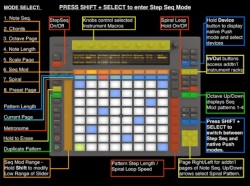Today Sonic Faction debuted their new Mutant Synth Pack, a collection of classic synthesizers for Ableton Live. The pack features meticulously sampled iconic synths, reactivated from the 70s, 80s, and 90s.
The bundle includes new 3 instruments:
- The Clone, based on the classic Roland SH-101
- Puls8or, sampled from the notorious Waldorf Pulse+
- and Rouge-One, modeled after the legendary Sequential Circuits PRO-ONE.
 Each synth in the collection has been exhaustively sampled from the original instrument to attain “fat, creamy” analog tones, and has at the same time been carefully re-programmed for the ease of playability inside of Ableton Live.
Each synth in the collection has been exhaustively sampled from the original instrument to attain “fat, creamy” analog tones, and has at the same time been carefully re-programmed for the ease of playability inside of Ableton Live.
Mutant Synth Pack also includes a custom Max for Live device to control sounds with the Ableton Push (screen capture, right), Akai APC40 and Novation Launchpad.
Mutant Step Sequencer key features:
- Melodic, Scale-Based Note Sequencer up to 64 steps
- Accented Notes
- Chord Generator for Polyphonic instruments
- Octave, Note Duration and Legato Slides
- Scale and Key Page with common and custom scales.
- Spiral LED and Melodic Pattern Generator
- Sequence Modulation (up to 4 parameters simultaneously)
- Preset and Pattern Recall
- Multi-Device/Multi-Controller Support — Use 1 controller on multiple tracks or up to 6 controllers on multiple tracks
The Mutant Step Sequencer allows you to draw in melodies, chords, and modulation and also features the unique Spiral LED light pattern generator.
More detailed information about the Mutant Synth Pack is on the Sonic Faction website.
Pricing and availability. Sonic Faction’s new Mutant Synth Pack is available now for $40 US from Sonic Faction.

These guys never do bad work. The video was a bit cutesy, but huzzah, I could feel the tone of the library and it was stout. Its a great time to be an Ableton or Reason user! That said (here it comes), how many VAs feel like “enough?” If you specifically want a Moog resource, that calls for some zeroing-in with purpose. Otherwise, how many VAs offer something unique that can’t be had elsewhere or programmed with a little sweat? Even modeled filters have differences I can see as a possible draw, but I prefer familiarity over endless novelty, which eventually wears off.
I respect the draw of a true analog synth; I’ve owned at least one synth from every family of sound production, so I can relate to their high & low points. Between Logic’s ES2 & EXS24 and Alchemy, I’m covered up with useful options. MiniMonsta grabs me because its close to my personal idea of a perfect mutant Moog. In fact, that’s the “MemoryMoog” people want as hardware, I’d think, but it’d cost a googillion dollars. So these days, I need less because I’ve learned how and where to tweak for the use at hand.
My question: Is your rig made up of a few familiar mainliners like mine, or do you stack up plugs until you’re getting Hard Disk Bloat from your GAS? I’m always curious about WHY people use what they use and why they discard or upgrade in various ways. I’d especially like to hear from Live users.
For hardware I use a DSI evolver, and DX7ii, in ableton I almost only use operator, but sometimes bring in FM8 for more complexity. I’ll use Analog very rarely, but I have no other 3rd party vsts… Just don’t see the point. Oh, sometimes I use Sampler as a wavetable synth. I don’t know, I used to collect vsts like crazy and eventually got really annoyed with it. Became a distraction.If I want a certain sound I rather take the time to turn virtual knobs and make it work with what I have.
This does look interesting and the audio previews sound great.
The wolf masks kind of freaked me out a little though.